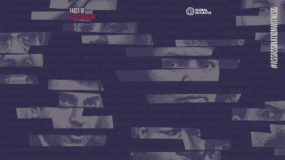Posted on 15 Jun 2020
Organized crime is indiscriminate in who it targets. Not only are conflicts between, and within, criminal groups often settled with violence, but such violence also regularly claims the lives of innocent people – those caught in the crossfire between rival criminal groups, or between criminals and the authorities.
There are also a very large number of those who are deliberately targeted for murder because they choose to take a stand against organized crime, or those whose job it is to investigate and end it.
In the years the Global Initiative Against Transnational Organized Crime has spent documenting and researching the criminal ecosystem, we have seen that, increasingly, criminal groups around the world are targeting those whom we can broadly categorize as civil society – people who choose to make social justice and the promotion of equality their life’s work. Such individuals are being assassinated because theirs are goals and aspirations and missions that confront and challenge the power, authority and local legitimacy of criminal interests the world over.
These are people seeking to do good by pushing back against organized crime, and its connections to economic and political interests. These are the people who are the subject of this study.
The people profiled in this book, Faces of Assassination, came from all walks of life; many of the ‘faces’ were journalists, community activists, political leaders, police officers; others were lawyers, businesspeople, educators or judges. No segment or class of society has been spared the impact of this form of criminal violence. They, and others like them today, were and are inspiring men and women, committed in their roles as human-rights organizers, political dissidents, academics, or whistle-blowers; all, in their own different ways, were campaigners for social justice.
Organized crime, of which assassinations are but one manifestation, is a difficult phenomenon to understand, and hard to define and investigate. With this book, we ask the international community to understand organized crime as a force that opposes the integrity, tenacity and principles shown by those who have stood against injustice and corruption, and paid the ultimate price for it. By focusing on the voices and stories of these faces of assassination, we hope to offer a different way of understanding organized crime as a phenomenon – and the very real impact it has on countries, communities and families.
Some of those whose profiles you will read here achieved public prominence within their lifetimes. Honduran activist Berta Cáceres, for example, was awarded the 2015 Goldman Environmental Prize, which brought her international acclaim and an audience with Pope Francis. Jacob Juma, another of the ‘faces’, one of Kenya’s wealthiest people, used his public platform to vehemently denounce and expose corruption in the Kenyan government.
But, although all are privately remembered, many are publicly forgotten. Some, after working tirelessly in the service of their local communities, became honoured posthumously because the way they were killed drew more widespread attention to their cause.
All are united in their quest for freeing their communities and societies from the corroding influence of organized-criminal actors.
In several of the profiles in this collection, the assassinated faces are remembered by friends, former colleagues and family members, and it is often repeated that the defining characteristics of these leaders was their strength of will and commitment to a sense of integrity and community spirit, even when threatened by reprisals from the underground forces opposing their objectives.
One may think of Slaviša Krunić, one of Bosnia’s wealthiest entrepreneurs, who was known for defying organized-crime bosses and corrupt political figures before he was shot dead on 22 April 2019. His relatives described how his commitment to his principles ultimately cost him his life.
Or of Rajendra Singh, an activist from India, who was described by his son-in-law as having ‘a madness in him for justice’.
Often, it seems, it was a personal driving sense of moral justice that brought such people into confrontation with those who would perpetuate injustice. Whether it was by writing an investigative report, refusing a bribe, exposing a corrupt individual or contract, all of those profiled here took a stand against organized crime in some way. By doing so, they paid with their lives because they refused to tolerate criminal governance or associated corruption.
Although the hallmarks of assassination are consistent across regions, there are some forms of assassination that are highly specific to particular social contexts, and are often shaped by long-standing criminal economies. Targeted religious killings in Nigeria, mayoral murders in Mexico and assassinations of journalists across Latin America have, for example, emerged as key regional trends in the course of our research.
There is one emerging theme that merits particular attention. Environmental defenders and activists are among those most frequently targeted for criminal assassination. Among those profiled here were organizers and activists opposing resource exploitation, such as leaders in the anti-poaching, illegal mining and ‘sand mafia’ community movements. These profiles are just a few examples of a vast problem of violence targeted at those who seek to protect our environment. According to one estimate, as many as 1 558 people in 50 countries were killed for protecting their environment and land between 2002 and 2017. As this publication went to press, two activists in Mexico who campaigned to protect the monarch butterfly were killed within days of each other, reportedly by groups connected to illegal logging.
While it is increasingly becoming understood that protecting the environment is the greatest challenge that humanity faces, it is simultaneously becoming clear that such an endeavour courts widespread violence meted out by criminal and corrupt interests.
Read more about our #AssassinationWitness campaign and sign-up to the Assassination Newsletter to get regular updates on the launch event.




